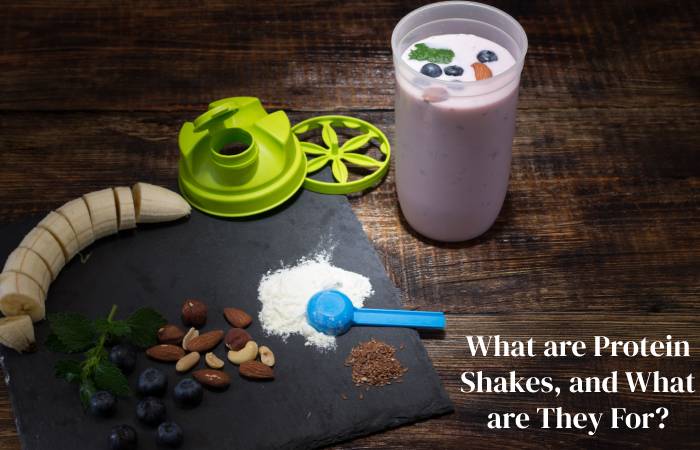Protein Shakes: What are They, What Are They For and How to Take Them? – There are numerous nutritional supplements available today. Each of them aims at a specific type of user, to whom it offers a series of benefits thanks to the properties of respective ingredients. Among all of them, one of the most consumed by society is the protein shake.
Table of Contents
What are Protein Shakes, and What are They For?
Essential amino acids that are present in structures classifies as proteins. Specifically, they use by the body for complete muscle regeneration, which also includes other important elements such as antibodies, hormones and even connective tissues.
These substances are present in protein shakes, designed to help the body regenerate all the essential elements that it has lost during sports activity.
Of course, those who don’t play sports can benefit from these products, but only by ingesting half of them. In these cases, 0.8 grams of protein multiplied by the total number of pounds a person weighs is sufficient. If you exercise regularly, the number is doubled to 1.6 or even higher, depending on the intensity of the activity.
This extra protein intake is challenging to achieve with a conventional diet. That’s why protein shakes are beneficial when it comes to gaining muscle. Without them, this goal can become more complicated or take much longer.
In addition to strengthening muscles, they also help increase blood glucose levels, which translates into a lot of energy. As if that wasn’t enough, they have a tremendous satiating component despite being low in calories, and they can also use to lose weight without causing a loss of muscle mass.
In addition to all this, there is an excellent recovery even during high-intensity physical activity. Resistance becomes considerably greater.
The powders that protein shakes usually sell can easily mix with liquid, from water to milk. The format helps in the ingestion, facilitating the preparation and later consumption. These drinks’ amino acid structures are present, reaching an extremely high percentage.
So, having mentioned, milk is prevalent for its whey use to make protein shakes. However, there are other sources from which it can derive.

Types of Protein Shakes
Whey:
Let’s start with the ones we’ve already mentioned and are currently the most popular. They are commonly known as Whey Protein, and their success lies in the ease with which all essential amino acids assimilate. In this way, physical recovery after sports activity occurs in record time.
Depending on how the whey is filtered, a more or less pure protein shake forms. However, those who want the highest purity level opt for hydrolyzed whey proteins. Opting for protein concentrate or protein isolate products also pays off in terms of the number of nutrients.
Carne:
The result is very similar to the protein shakes mentioned above, although they are different in one crucial respect: they do not contain lactose. Everything else is almost identical, including how quickly the body assimilates its substances.
It is an excellent alternative for those who would like to benefit from Whey Protein but cannot because of its high lactose content, for example, those who are lactose intolerant.
Casein:
A mixture of phosphorus and calcium is found in milk and can be extracted in the form of casein to make protein shakes which, although they come from the same ingredient as whey protein, are very different.
In this case, the release occurs very slowly. It takes time for the body to digest the product handled. For this reason, it is advisable to take it before bed or at any time of the day, after which no food should take for a few hours.
Sequential Release Jitters:
Although there are protein shakes like the egg shake, which we will see later, that release sequentially, others like the one recently described do so very slowly. Mixing them with other proteins, such as whey, ensures that sequential release predominates.
It demonstrates by protein shakes that combine whey and casein. Absorption will be optimal, varying the number of amino acids available in the athlete’s blood.
Legumes:
We are speaking of alternatives. It’s time to tackle one of the most popular ones. We’re referring to plant-based protein shakes, which avoid ingredients from animals.
Vegan diets and vegetarian diets can include this type of product that characterizes by providing a large number of amino acids. This amount varies depending on the ingredient from which it comes, from hemp to soy, peas and rice.
Eggs:
If animal products do not impede the athlete’s diet in question, egg albumin protein shakes are highly recommended and successful. They are currently only ahead of Whey Protein in terms of sales numbers.
It is not surprising, given egg shakes’ very high biological value. Additionally, they are released into the bloodstream in a sequential process, making them highly versatile for those looking to gain muscle mass, who can consume the shake without doing so at a specific time of day.
When to Drink a Protein Shake
While it depends on the goal each athlete has in mind, there are usually several times that are ideal for protein shakes.
A clear example is in the morning. The body spends the night without food reserves, a factor that leads to muscle catabolism. The situation whole reversed when drinking a shake, mainly if it contains fructose. As a result, the liver replenishes with a considerable amount of glycogen, and the loss of muscle mass stops for half an hour.
It is also common for a protein shake to consume during the training or physical activity in question. It is not strictly necessary but is generally for good performance. Specifically. This is usually done thirty minutes before the start of exercise. Although not many hours have passed since the morning product.
The one that is 100% recommend the one that ingests after the sports session. It doesn’t matter the intensity level of the session because, in all cases, there will have been a loss of glycogen that affects the musculature. It is essential to drink a protein shake within half an hour for optimal assimilation for full muscle recovery afterwards.

How Many Protein Shakes to Drink Per Day
Countless features come into play when setting an exact number, from your weight to the type of diet you follow. For example, eating protein-rich foods is not the same as eating a low-protein diet.
A daily protein shake, preferably taken after physical activity, will probably suffice in the first case. But suppose for financial or other reasons, it is impossible to include protein in your regular diet. In that case, the maximum number of shakes recommended by health professionals as a dietary supplement is three.
Adverse Effects of Protein Shakes
Having just mentioned health experts now the time to address the importance of consulting with them before initiating any significant changes in your habits. A clear example is starting to drink protein shakes.
A nutritionist will know how to guide you so that you ingest the ideal amount and do not exceed the maximum values, which could result in several adverse effects, such as deficiencies in minerals and vitamins and damage to the liver and kidneys.

